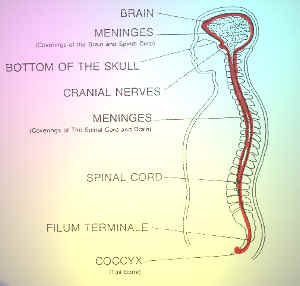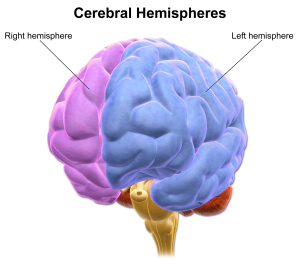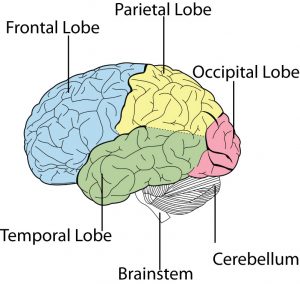Find Out How Your Brain and Nervous System Work – Part 2
Part 2: A quick introduction to the parts of your brain
The brain is the most complex organ in the human body. It controls all vital functions of the body; it receives and processes information from the outside world; it forms the essence of who we are (mind and soul); and it determines various other traits of our personality such as intelligence and creativity. The five senses of sight, smell, taste, hearing, and touch receive information and pass it on to the brain. The brain processes the input and determines what kind of response is needed. It also stores information in the form of memories. Speech, movement, thoughts, and emotions are governed by the brain, as well as the function of all organ systems from breathing to heart rate and digestion. Indeed, every single cell of your body communicates with the brain on an ongoing basis.
The main parts of the brain: forebrain, hindbrain, brain stem

The brain has three main parts: the forebrain (cerebrum), the hindbrain (cerebellum), and the brainstem. The forebrain is the largest part. It is responsible for higher functions such as interpreting touch, vision and hearing; it also executes and interprets speech and facilitates reasoning, emotions, learning, and fine control of movement. The hindbrain is responsible for movement, balance, and a sense of where your body is in space (proprioception). It lies below the forebrain, towards the back of the head. The brainstem is the lowest part of the brain. It is a relay station between the brain and the spinal cord. Important functions such as breathing, heart rate, body temperature, sleep-wake cycles, sneezing, coughing, swallowing, and digestion are regulated here. Most of the nerves relating to smell, taste, vision, and hearing are also located here.
Keeping your brain protected: the skull and meninges

The brain is protected by the skull, which is made up of 8 bones that fuse along suture lines. These include the frontal, parietal (2), temporal (2), occipital, sphenoid, and ethmoid bones. The face is made up of 14 paired bones, some of which are quite tiny and delicate.

Because the brain is so delicate, it doesn’t want to rub against the inside of the skull. For this reason, it is protected by various means. It is surrounded by layers of protective tissue, the so-called meninges (men-in-geez). These are very thin yet very strong. Their role is to separate the brain from the skull bones and to provide space for the cerebrospinal fluid which bathes and cushions your brain (think of your brain as floating inside your skull). The white part of your eye (sclera) is a continuation of the same tissue. The meninges also play an important part in connecting your immune system to your brain: they house tiny channels which facilitate direct communication of the lymphatic system (which is an important part of the immune system) to the brain. The meninges furthermore surround the entire spinal cord like an elastic tissue tube. They protect the spinal cord inside the spine and keep it anchored in place. These delicate tissues therefore play a key role in keeping your brain and body healthy and stable. When we treat you with Advanced Biostructural Correction™ (ABC™), we always check the meninges to make sure there are no distortions which hold back your healing process.
Left brain – Right brain

The brain has two hemispheres (left and right), which are joined in the middle by a bundle of fibres called the corpus callosum. This structure delivers messages from one side to the other. Each hemisphere controls the opposite side of the body. If, for example, there is a stroke or tumour on the right side of the brain, it may interfere with the function of the left arm or leg. The left hemisphere controls speech, comprehension, writing, and arithmetic. The right hemisphere is responsible for creativity and artistic or musical skills, as well as spatial awareness.
Brain lobes

The hemispheres are divided into separate parts called lobes. Each hemisphere has four lobes: frontal, temporal, parietal, and occipital. Their main functions are as follows:
Frontal lobe:
- Personality, behaviour, emotions
- Judgement, planning, problem solving
- Speech (speaking and writing)
- Movement (motor cortex)
- Intelligence, concentration, and self-awareness
Parietal lobe:
- Sense of touch, pain, temperature (sensory cortex)
- Interpretation of language and words
- Interpretation of signals from vision, hearing, motor and sensory cortices, and memory
- Spatial and visual perception
Occipital lobe:
- Interprets vision (colour, light, movement)
Temporal lobe:
- Understanding language
- Memory
- Hearing
- Organisation and sequencing
Messages travel from one lobe to another, from one hemisphere to the other, and to structures deep within the brain (thalamus, hypothalamus), which function as relay stations and centres of hormone production.
All the different parts of the brain work together tirelessly to regulate every part and function of your body. The brain truly is the body’s master control station.
When we check your body with Advanced Biostructural Correction, we address misalignments in the bones of your spine or skull. We also address any distortions in the meninges. All this contributes to keeping your body and brain healthy and functioning at its best.
Stay tuned for the next post in the series: it will discuss the spinal cord and how it works as an information super-highway that connects your brain to the rest of your body. In the meantime, come in for a free consultation to see how ABC™ can keep your body and brain healthy.
Images: Wikimedia.



